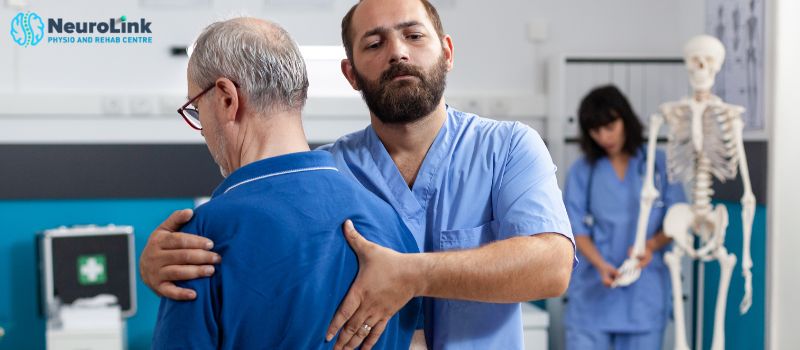A stroke, often referred to as a cerebrovascular accident (CVA), occurs when blood flow to a part of the brain is interrupted or reduced, depriving brain tissue of oxygen and nutrients. This can lead to brain cells dying within minutes, making stroke a medical emergency that requires immediate intervention. Understanding the treatment and rehabilitation process for stroke patients is crucial in minimizing damage and promoting recovery.
Types of Stroke
There are three main types of strokes:
-
Ischemic Stroke: This is the most common type, accounting for about 87% of all strokes. It occurs when a blood clot blocks or narrows an artery leading to the brain. These clots often form in areas where arteries have been narrowed by fatty deposits called plaques.
-
Hemorrhagic Stroke: This type occurs when a blood vessel in the brain bursts, causing bleeding in or around the brain. High blood pressure, aneurysms, and trauma can lead to hemorrhagic strokes. There are two types: intracerebral hemorrhage (bleeding within the brain) and subarachnoid hemorrhage (bleeding in the space between the brain and the surrounding membrane).
-
Transient Ischemic Attack (TIA): Also known as a mini-stroke, TIA is a temporary period of symptoms similar to those of a stroke. A TIA doesn’t cause permanent damage and is usually caused by a temporary decrease in blood supply to part of the brain.
Symptoms of Stroke
Recognizing the signs and symptoms of a stroke is vital for timely treatment. Symptoms include:
- Sudden numbness or weakness in the face, arm, or leg, particularly on one side of the body.
- Sudden confusion, trouble speaking, or understanding speech.
- Sudden trouble seeing in one or both eyes.
- Sudden trouble walking, dizziness, loss of balance, or lack of coordination.
- Sudden severe headache with no known cause.
Immediate Treatment
The immediate goal of stroke treatment is to restore blood flow to the brain. The approach varies depending on the type of stroke.
Ischemic Stroke Treatment
For ischemic strokes, treatments aim to dissolve or remove the blood clot:
- Thrombolytics: Medications such as tissue plasminogen activator (tPA) can dissolve clots if administered within 4.5 hours of symptom onset.
- Mechanical Thrombectomy: A catheter is used to physically remove the clot from the blocked artery. This procedure is most effective when performed within six hours of stroke onset but can be done up to 24 hours in some cases.
- Anticoagulants and Antiplatelet Drugs: These medications help prevent new clots from forming and existing ones from growing.
Hemorrhagic Stroke Treatment
For hemorrhagic strokes, the focus is on controlling bleeding and reducing pressure on the brain:
- Medications: Drugs may be administered to control blood pressure, reduce brain swelling, and prevent seizures.
- Surgical Intervention: Procedures like aneurysm clipping, coiling, or arteriovenous malformation (AVM) repair can help stop the bleeding.
- Supportive Care: Managing intracranial pressure and ensuring adequate oxygen supply to the brain are critical components.
Rehabilitation After Stroke
Recovery from a stroke often involves a comprehensive rehabilitation program. The goal is to help the patient regain as much independence and function as possible.
Physical Therapy
Physical therapy focuses on improving motor skills, balance, and coordination. Therapists use exercises to strengthen muscles, improve walking, and increase overall mobility. They also help patients relearn basic movements and activities.
Occupational Therapy
Occupational therapists assist patients in regaining the ability to perform daily activities, such as dressing, eating, and bathing. They provide strategies and adaptive tools to help patients manage daily tasks and improve their quality of life.
Speech and Language Therapy
Speech-language pathologists work with patients who have difficulty speaking, understanding speech, reading, or writing. Therapy includes exercises to improve communication skills and techniques to help with swallowing difficulties, a common issue after a stroke.
Psychological Support
A stroke can have a significant emotional and psychological impact. Counseling and support groups can help patients and their families cope with the changes and challenges that follow a stroke. Addressing mental health is crucial for overall recovery and well-being.
Lifestyle Changes and Prevention
Preventing another stroke is a key part of the rehabilitation process. Lifestyle changes and medical management play crucial roles:
- Healthy Diet: A diet low in saturated fats, cholesterol, and sodium can help manage blood pressure and reduce the risk of further strokes.
- Regular Exercise: Physical activity helps control weight, lower blood pressure, and improve cardiovascular health.
- Smoking Cessation: Quitting smoking reduces the risk of stroke and improves overall health.
- Medication Adherence: Taking prescribed medications, such as blood thinners, statins, and antihypertensives, is essential in preventing recurrent strokes.
- Regular Check-ups: Ongoing medical supervision helps monitor and manage risk factors like high blood pressure, diabetes, and high cholesterol.
Technological Advances in Stroke Treatment and Rehabilitation
Recent advancements in technology have significantly improved stroke treatment and rehabilitation outcomes:
- Telemedicine: Remote consultations and monitoring allow patients to receive timely medical advice and support, particularly in emergency situations.
- Robotics: Robotic devices assist in physical therapy, providing repetitive, precise movements to help regain motor function.
- Brain-Computer Interfaces (BCIs): BCIs can help restore movement and communication in patients with severe disabilities by connecting the brain to external devices.
Conclusion
Understanding stroke treatment and rehabilitation is crucial for improving outcomes and quality of life for stroke survivors. Early recognition of symptoms, prompt medical intervention, and comprehensive rehabilitation programs are essential in maximizing recovery. By adopting a healthy lifestyle and adhering to medical advice, patients can reduce the risk of recurrent strokes and lead fulfilling lives.

